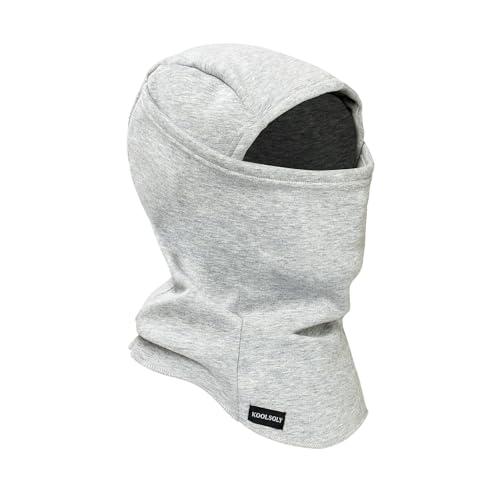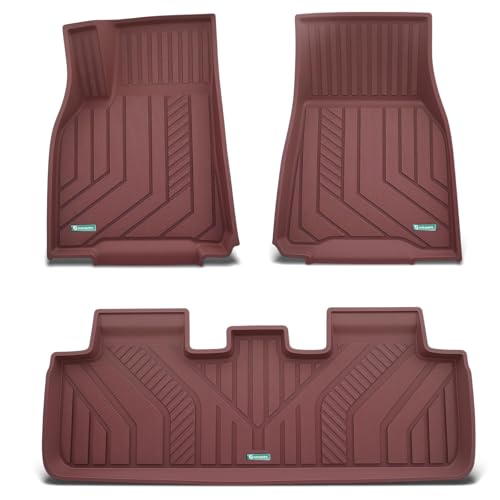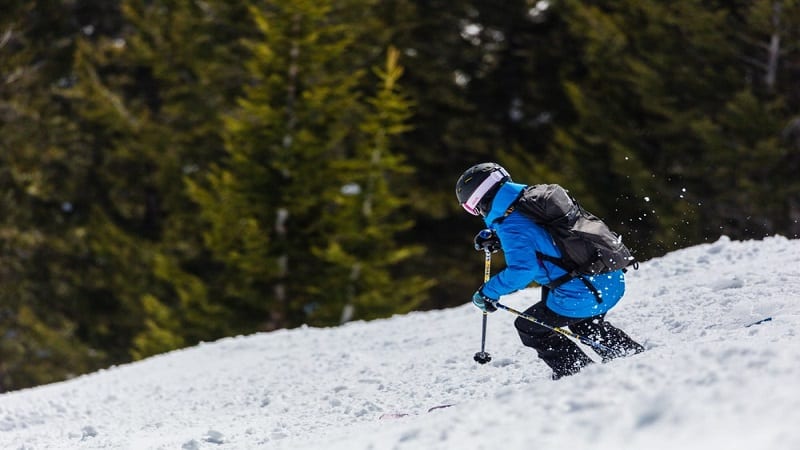Ever tried skiing after a fresh rainfall? It’s an experience that many shy away from, but trust me, it can be more thrilling than you might think! You know how they say: “No rain, no rainbow.” Well, in this case, the ‘rainbow’ is the unique adventure that awaits you on those glossy slopes.

Rain changes up the game completely for skiers. The snow becomes denser and that shiny surface may look intimidating at first. But don’t let it dampen your spirits! You’ll find yourself navigating the slopes differently and discovering new techniques to maintain control.
You should keep in mind though – skiing post-rain requires a different approach. So before you zip up your jacket and strap on your skis, there are some important things you need to consider. But hey, don’t worry! We’re here to guide you through it all.
Understanding Weather Impact on Skiing
Hey, let’s talk about weather and skiing! You might be wondering – what’s the big deal? Well, weather plays a pivotal role in your skiing experience. From sunshine to rain, different weather conditions can alter not only the quality of snow but also your overall safety on the slopes.
Rain is one such element that significantly impacts skiing conditions. After a rainfall, you’ll typically find the once powdery and fluffy snow turning into slush or hard-packed ice. This transformation can make it difficult for skis to glide smoothly over the surface. Also, as you ski in these conditions, there’s an increased risk of slipping and falling due to reduced friction between your skis and the icy surface.
Don’t let this discourage you though! If you’re a seasoned skier or even someone looking for an added challenge, these post-rain skiing conditions can provide an exciting new experience. It demands higher levels of balance and control from you – testing your skills like never before!
Here are some stats to back up how weather affects ski resorts:
| Weather Condition | Impact on Ski Resorts |
|---|---|
| Snowfall | Increases visitors |
| Rains | Decreases visitors |
| Mild Temperatures | Varies |
Keep in mind that while skiing after rain may seem daunting at first, with proper precautions and gear adjustments (like using wider skis for better stability), it’s entirely doable!
Just remember – no matter what Mother Nature throws at you on those slopes, always prioritize safety above all else when hitting the trails post-rainfall.
That sums up our take on understanding how rain impacts your beloved winter sport. Stay tuned for more interesting insights into other aspects of skiing in our upcoming sections!
How Rain Affects Snow Conditions
Ever watched the rain pouring down on your favorite ski hill and felt a pang of despair? Don’t worry, you’re not alone. It’s a common feeling among winter sports enthusiasts. But how exactly does rain affect those snowy slopes?
First off, let’s talk about the immediate impact. When it rains, the water droplets seep into the snow, making it denser and more compact. You’ve probably noticed that post-rain snow feels heavier under your skis or board. That’s because it gets saturated with water which increases its weight.
- Impact on Skiing: Skiing in this kind of ‘wet’ snow can be challenging for beginners as it requires more strength and control than lighter powdery snow.
But what happens when temperatures drop again after a rainfall? Well, that once fluffy layer of powder turns into a hard crusty surface known as “rain crust”. This is due to the refreezing process where all those absorbed water particles turn back into ice.
- Impact on Safety: This condition can lead to slippery conditions which increase risks for skiing accidents
Now let’s delve deeper into how long-term weather patterns influence snow conditions. If an area experiences frequent rain followed by freezing temperatures (think: typical springtime weather), then it could result in icy conditions persisting for days or even weeks at a time!
- Long-Term Impact: Frequent cycles of rain and freeze can cause deterioration in overall slope quality over time.
So while we’d all prefer a steady supply of fresh powder, don’t feel too disheartened next time you see those grey clouds rolling in! Understanding how changing weather patterns affect ski conditions is key to adapting your skills and equipment accordingly – ensuring you get the most out of every trip to the mountain regardless of what Mother Nature has in store.
Preparation for Skiing After Rain
Let’s face it; Mother Nature doesn’t always cooperate with our outdoor plans. You’ve been looking forward to that ski trip for weeks, and then it rains. Don’t let a little rain get you down! With the right preparation, skiing after the rain can still be an enjoyable experience.
First things first, check the weather forecast before you head out. If it has recently rained or is still raining at your chosen ski resort, there may be some changes in snow conditions. The slopes might be icier and faster than usual due to the melted and refrozen snow.
Next up: gear up properly! In wetter conditions, waterproof clothing becomes essential:
- Invest in a high-quality waterproof jacket. Look for one that’s not just water-resistant but fully waterproof.
- Get yourself a pair of waterproof pants too because soggy jeans are no fun on the slopes.
- Don’t forget about your feet! Waterproof socks and boots will keep your toes dry even if you accidentally step in a puddle or two.
Skiing after rain also calls for special attention to safety measures:
- Be more cautious when choosing your runs as icy patches can make certain slopes riskier than they would normally be.
- Keep an eye out for any closed signs; these areas could have become particularly dangerous since the rainfall.
Lastly, remember it’s all about having FUN! So what if conditions aren’t perfect? Embrace the challenge that skiing after rain presents – It might turn out to be one of your most memorable adventures yet!
So don’t let those storm clouds burst your bubble – with just a little prep work, you’ll find there’s no such thing as bad weather…just different kinds of good weather!
Suitable Equipment for Wet Snow Skiing
When the clouds part, and you’re staring down a mountain glistening with wet snow after a hefty rainfall, it’s crucial to have the right gear. The equipment you use can make or break your skiing experience on soggy slopes.
First and foremost, let’s talk about skis. Skis designed for slushy conditions are typically wider with a softer flex pattern. These features help them float atop the wet snow instead of sinking in. Rossignol Soul 7 HD and Nordica Enforcer 100 are both great choices when it comes to wet snow skiing.
Next up: ski boots. They’re an essential piece of your equipment lineup. You’ll want something waterproof and well insulated to keep your feet dry and warm in damp conditions. Brands like Salomon, Atomic, or Tecnica offer exceptional ski boots that tick these boxes.
Keeping our focus downward – don’t forget about socks! A good pair of moisture-wicking socks is a game-changer on rainy days where regular cotton just won’t cut it. Look into investing in merino wool socks; they’ve got excellent temperature regulation capabilities while remaining breathable.
But what about protection from falling rain? That’s where your outerwear comes into play! Opting for a top-quality waterproof jacket is key here – one equipped with Gore-Tex technology will ensure no water seeps through while allowing sweat (yes, skiing can be hard work!) to evaporate easily from within.
Lastly, gloves shouldn’t be overlooked either! Wet hands mean cold hands which can quickly put a damper on any skiing adventure. Grab yourself some water-resistant gloves which also feature insulation for those colder days out on the slopes.
Skiing after rain doesn’t have to be an ordeal – not if you’ve geared up correctly! With these items in your arsenal, you’re ready to conquer any post-rain ski run thrown at you, and maybe even enjoy it. So gear up, hit the slopes, and make the most of that wet snow!
Safety Measures for Skiing Post-Rainfall
Ever been caught in a pickle, wondering if it’s safe to ski after a rainstorm? You’re not alone. It’s a common question among winter sports enthusiasts. The truth is, skiing post-rain can be safe and enjoyable, but you have to take some extra precautions.
First things first – check the weather forecast before you decide to hit the slopes. After rain, temperature fluctuations can create icy conditions that are challenging even for seasoned skiers. So ensure that there are no sudden drops in temperature or freezing conditions predicted.
Now let’s talk about gear. Your equipment can make all the difference when you’re navigating wet snow or potentially icy patches. Here’s what you need:
- Skis with sharp edges: These will provide better grip on hard-packed snow.
- Waterproof clothing: Staying dry means staying warm.
- Goggles with good visibility: Overcast skies often follow rainfall; goggles will keep your vision clear.
Let’s not forget about slope selection. Some trails drain better than others after rainfall, making them safer options for post-rain skiing adventures. Stick to groomed runs where possible as they’ll likely have consistent coverage and less ice formation.
Lastly, don’t underestimate the importance of taking it slow and steady out there! Wet snow is heavier which makes turning more difficult than usual which increases your risk of injury if you fall at high speed.
So next time when rain has just given way to bright skies and fresh snow awaits you on those beautiful mountain slopes – remember these safety measures! Happy skiing!
Benefits of Skiing in Diverse Weather Conditions
There’s a certain charm to skiing on a bright, sunny day when the sky’s as clear as crystal. But have you ever tried hitting the slopes after a rainstorm? If not, you’re missing out! Skiing in diverse weather conditions can actually be quite beneficial.
First and foremost, it enhances your skills. You’re pushed to adapt your techniques to handle different types of snow and terrain conditions. Soft, mushy snow demands more balance and control than the dry powder you’d normally encounter. The result? You become an all-around better skier.
Secondly, let’s talk about crowding – or rather, lack thereof! Ski resorts are typically less crowded after a rainfall because many people assume it’s not ideal for skiing. But that just means more space for you to enjoy your downhill runs without worrying about bumping into others.
Thirdly, here’s something unexpected: Rainwater can actually improve snow quality! When rain falls on existing snowpack, it percolates through the layers and refreezes overnight. This creates what’s known as “corn” snow – a granular type that’s super fun to ski on!
Now if you’ve got any concerns about wet gear or visibility issues during cloudy days, don’t fret. Modern ski equipment is designed to withstand varied weather conditions while keeping you warm and dry. Plus foggy goggles are easily remedied with anti-fog sprays or wipes!
So next time it rains before your scheduled ski trip, don’t let it put a damper on your plans – embrace this chance for an exciting new experience!
Personal Experiences: Thrills of Skiing After Rain
Picture this. You’ve been eagerly waiting for that perfect day to hit the slopes, but Mother Nature has other plans. Instead of fluffy white snowfall, there’s a downpour! But don’t be disheartened – skiing after rain can offer its own unique thrills and challenges that are worth experiencing.
You’re probably wondering how in the world could wet slopes be exciting? Well, for starters, it’s all about the speed! The water from the rain acts as a lubricant on the surface of the snow, making your descents faster than usual. Imagine yourself swooshing down those slopes at lightning speed – now that’s an adrenaline rush!
But it’s not just about going fast. Skiing after rain brings out nuances in terrain you might not notice otherwise. Your senses are heightened as you navigate through slick paths and maneuver around unexpected obstacles. It’s like rediscovering your favorite ski hill all over again!
Now let’s talk about tranquility. Fewer people venture out when it’s rainy which means less crowded lifts and more peaceful trails for you to enjoy. Imagine having all that space to yourself – it’s almost therapeutic.
Remember though, skiing post-rain is definitely challenging with increased risks due to slippery conditions and low visibility sometimes which only adds to the thrill factor! So before you go sliding off into the wet wilderness, ensure you’re well-equipped and aware of safety precautions.
Here are few tips if you decide to take on this adventurous endeavor:
- Keep your goggles clear: Rain can fog up or wet your goggles affecting visibility.
- Wax your skis: A good wax job helps deal with sticky snow.
- Dress appropriately: Waterproof gear is a must!
- Stay safe: Be conscious of changing trail conditions and potential hazards.
So next time if rain threatens your ski day plans, remember there’s always a different kind of adventure waiting for you!
Conclusion: Embracing the Challenge
So, you’ve come to the end of your journey, huh? Well, let’s wrap things up. Skiing after rain might seem like a bummer at first. You might think it’s all slushy slopes and damp clothes. But hey, remember when we talked about how much fun it can be?
It’s time to see skiing after rain as an opportunity rather than a setback. It’s not just about tackling those slippery slopes – it’s also about challenging yourself and growing as a skier. Sure, conditions aren’t going to be perfect every time but isn’t that what makes it interesting?
Here are some key points to take away from this article:
- Rain doesn’t always mean bad news for skiing.
- Skiing after rain can help improve your skills.
- Proper gear and preparations make a huge difference.
Getting out there on the mountain right after a rainfall is not everyone’s cup of tea, but don’t knock it until you’ve tried it! It could turn into your new favorite way to ski!
Remember – embrace the challenge and have fun with whatever Mother Nature throws at you on the slopes! With enough persistence and determination, you’ll master those wet runs in no time.
That’s all folks! Now grab your gear, hit the slopes and make some unforgettable memories out there!














